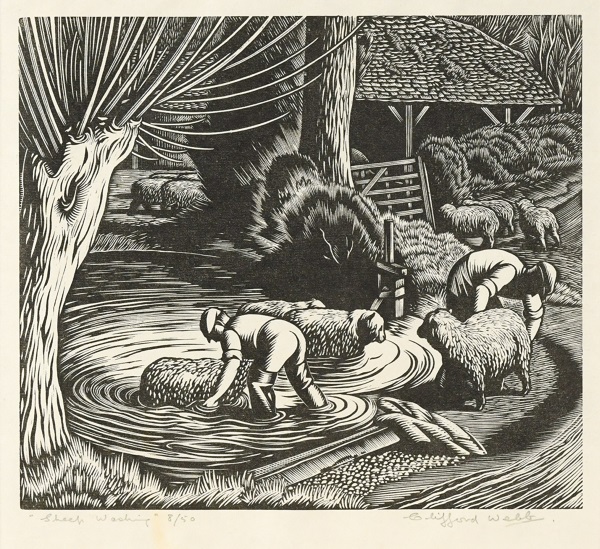Put simply, wood engraving is a relief form of printmaking, usually using a block of boxwood, which became widely used in the nineteenth century before seeing a revival in the 1920s. It is thought to be the only art form which was invented in Britain. Devised by a Northumbrian engraver, Thomas Berwick, wood engravings were used to illustrate newspapers and books, before being replaced by photography. However, wood engraving saw a resurgence in the 1920s, when the Society of Wood Engravers was established, founded by Eric Gill and Gwen Raverat. Wood engravings then started to be commissioned again and were used for illustrating books or even commercial labelling (such as at Glenmorangie) or for the Royal Mail’s Twelve Days of Christmas stamp series in 1977, which then saw its designs writ large across Charing Cross train station. Some of the most famous artists who created wood engravings were Eric Ravilious, Christopher Wynne Nevison, Agnes Miller-Parker, Clifford Webb and Gwen Raverat.

Lot 281, Boy Birdnesting by Eric Ravilious - estimate £800 - £1,200
Created using tools traditionally used for metal engraving, wood engravings are admired for their extraordinary precision and meticulous detail and have for the past few decades been surprisingly affordable, with even examples by the leading lights of the genre only selling for a few hundred pounds. This has made wood engravings a joy for collectors, able to be sourced at regional auction houses up and down the country for under £1,000, despite the huge levels of complexity and detail which has gone into their creation.
However, we have seen recently that whilst several wood engravings can still be bought cheaply, even by big 20th century names, there appears to be a rising interest within the market. This may be because of the successful exhibition hosted by The Ashmolean Museum in 2020, Scene Through Wood, or simply be another part of the burgeoning demand for 20th century Mod-Brit works of art. As an example, at The Art & Design Sale at Cheffins in February, a signed wood engraving by Tirzah Garwood sold for £11,000, against an estimate of £2,500 - £4,000, setting a record for the artist. A picture such as this may only have made approximately £500 several years ago.

Lot 291 - Boys Skating by Agnes-Miller Parker, estimate £300 - £500
In the next Art & Design Sale at the end of the month, we will be selling thirty-three wood engravings from one private collection, including eleven by the legendary Eric Ravilious, husband of Tirzah Garwood. Ravilious was one of the leading wood engravers of the 1920s and was frequently commissioned to create images for some of the major literary works of the period. He continued to work primarily in wood engraving until the late 1930s, when he abandoned the practice in favour of watercolour painting. All from one collection, these 33 works also include examples by Clifford Webb, Eric Gill and Agnes Miller-Parker. Many are signed and dated by the artists and some of the Ravilious examples were used as illustrations for books published by the Golden Cockerel Press.

Lot 296 - Sheep Washing by Clifford Webb, estimate £200 - £400
Estimates for the pictures range from around £100 for works by Robert Gibbings or Noel Rooke, whilst wood engravings signed by Ravilious, may realise more than £1,200. All with incredible amounts of detail and with a variety of subject matter, these pictures provide a great entry point for someone looking to start a Modern-British art collection. For new collectors, a good place to begin could be a picture by Agnes Miller-Parker, who was one of the most gifted engravers of her generation and who created some easily recognisable pieces, but which are available from around £200. Anyone wanting to get into collecting wood engravings should look out for signed and dated examples, as these always will hold their value.
The Art & Design Sale will take place on Thursday 26th May, to view the catalogue, please click here.